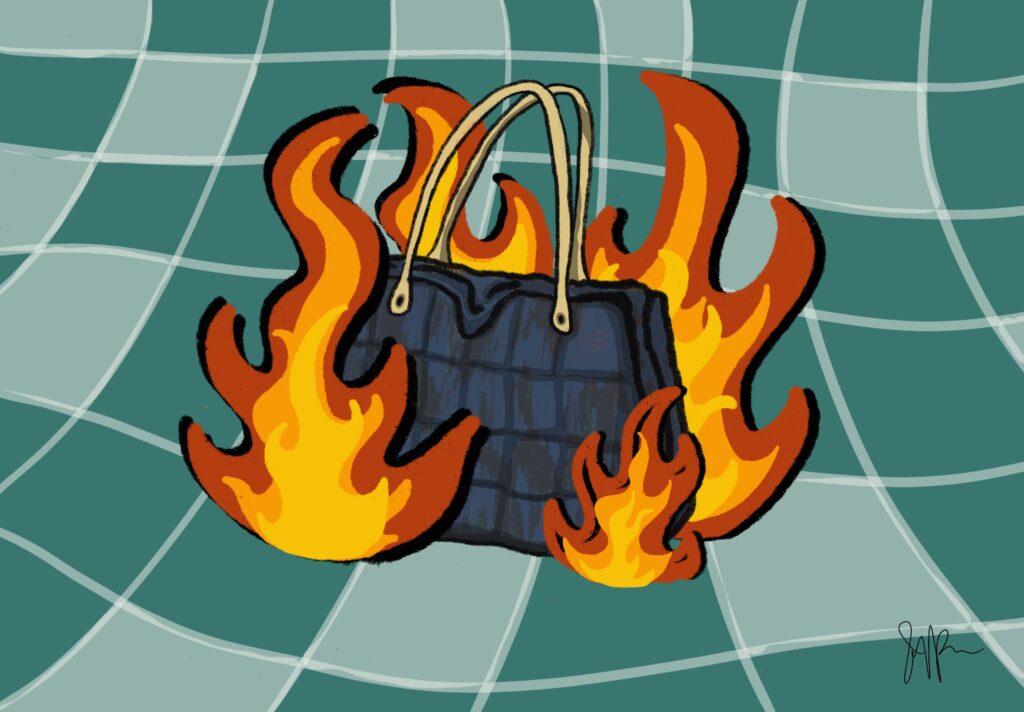
Burberry, Chanel, Louis Vuitton, Cartier…
We’ve all heard of them, seen them—maybe even gawked (or tutted your tongue) at them and their prices while walking past their stores in the mall. And despite their seemingly unachievable prices marked at thousands of dollars, we hardly ever see any luxury brand go out of business. In fact, the more expensive the price tag reads, the more desirable the product seems to become—as implied by the lines only seen outside these high-end retail stores at the mall.
But not too long ago, a shocking truth about these multi-billion brands came to light: every season, millions of dollars worth of these unsold products make their way to the landfill, the incinerator, and other places where they are ultimately destroyed.
It seems counter-intuitive and like a tremendous financial loss. Why would any brand destroy its own merchandise?
The answer is in the intricate interplay of overproduction and exclusivity.
For decades, luxury brands have focused their marketing around the value of exclusivity. In an increasingly fast-paced world where products are mass-produced at cheap costs yet high quality, it’s become harder to secure a place in the fashion industry with an element that sets brands apart from others. Luxury brands are simply competing in such an industry by upholding their exclusivity through strategic measures—one of them being the mass destruction of their unsold products. Making sure that every last product is sold on-season rids the brands from having to discount any remaining last-season items. With supply low and demand high, luxury brands obtain the power to sell their products at high prices, gaining enough of a profit margin that keeps them from hardly blinking an eye at the millions of dollars worth of merchandise that is intentionally put to waste.
Fortunately, the European Union has begun to take steps to curb the wasteful practice, recognizing the resulting immense environmental damage and carbon emissions from the destruction of more than six million tons of textiles every year. First proposed by the European Commision in March 2022 and passed in May 2023, the Ecodesign for Sustainable Products Regulation has finally been put into action this past summer, banning the destruction of unsold goods, especially textiles and footwear.
The ESPR is part of the 2020 Circular Economy Action Plan, aiming to promote an sustainable economic system based on reusing and regenerating products. The legislation on product destruction outlines a plan that should be complete by about 2028, given that transitional periods may take up to four years for companies depending on their size. Large companies like the multi-billionaire luxury brands, on the other hand, have been required to comply within two years of the regulation’s final approval this summer. As of 2026, therefore, we expect to see a significant reduction in the waste and incineration of textiles in the EU, as brands like Louis Vuitton alone have been reported to produce more than a hundred thousands tons of textile waste.
Along with the closing-in on product destruction, the ESPR has also introduced the “digital product passport”, which will require producers to disclose how many unsold consumer products they discard each year and inform consumers of the environmental impact of their purchases. With this, the EU hopes to curb not only companies’ overproduction, but also the average person’s overconsumption.
This regulation poses significant implications for every enterprise in the fashion industry, but also creates a need for the re-evaluation of marketing strategies for the luxury industry, as they can no longer rely on destruction to maintain exclusivity or brand value. This is a crucial step in the fight against the increasing waste and greenhouse gas emissions each year.
Moreover, this conversation speaks to the changing dynamics of consumerism, where the value placed on exclusivity is being challenged by a growing emphasis on ethical practices. The new EU law not only reshapes the luxury market but also challenges consumer patterns, pushing both brands and buyers to reconsider the cost of luxury, beyond its price tag.
As we witness this shift, it becomes more apparent that true luxury may no longer lie in rarity alone but in practices that respect both the consumer and the environment.
Sources:
“Companies Selling Consumer Products in the EU (Particularly Clothing, Apparel, and Footwear Companies) BEWARE: The New ESPR Rules on Unsold Consumer Products Have Now Entered into Force.” Crowell & Moring – Companies Selling Consumer Products in the EU (Particularly Clothing, Apparel, and Footwear Companies) Beware: The New ESPR Rules on Unsold Consumer Products Have Now Entered into Force, 6 Sept. 2024, www.crowell.com/en/insights/client-alerts/companies-selling-consumer-products-in-the-eu-particularly-clothing-apparel-and-footwear-companies-beware-the-new-espr-rules-on-unsold-consumer-products-have-now-entered-into-force#:~:text=Certain%20companies%20which%20operate%20in,products%20on%20their%20website%20annually.&text=Perhaps%20most%20significantly%3A%20as%20from,apparel%2C%20clothing%20and%20footwear%20products.
“Ecodesign for Sustainable Products Regulation.” European Commission, commission.europa.eu/energy-climate-change-environment/standards-tools-and-labels/products-labelling-rules-and-requirements/ecodesign-sustainable-products-regulation_en.
The views and opinions expressed are those of the authors and do not necessarily reflect nor represent the Earth Chronicles and its editorial board.




